 Artist N. C. Wyeth's depiction of Frederick's Barbara Fritchie (1922) Artist N. C. Wyeth's depiction of Frederick's Barbara Fritchie (1922) We celebrated one of Mount Olivet Cemetery’s most beloved inhabitants with a milestone birthday back on Saturday, December 3rd, 2016. This spunky, nonagenarian put our town (and county) on the map —“The bravest of all in Frederick town, She took up the flag the men hauled down.” Her amazing tale of patriotism would certainly have a major impact on future tourism, commerce and historic preservation efforts. Frederick wouldn’t be the same without this lady, and she wouldn’t have been the same without Frederick. We can thank this lady and a poet from Amesbury, Massachusetts for immortalizing our magical setting complete with “green-walled hills and clustered spires.” Of course, I’m referring to Barbara Fritchie, a native of Lancaster, Pennsylvania who moved with her German immigrant Hauer family to Frederick as a young girl on the eve of the American Revolution. The majority of Fritchie’s storied life would be spent in a burgeoning town, at the time located on Maryland’s western frontier. 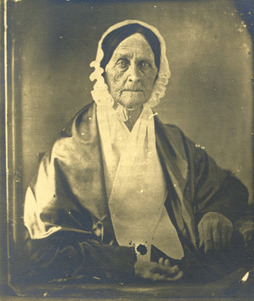 Jacob Byerly's photograph of Barbara Fritchie taken c.1859 Jacob Byerly's photograph of Barbara Fritchie taken c.1859 Barbara Fritchie witnessed the early history of our nation. She experienced our country gaining independence from Great Britain, and a successful effort to keep it after the British destroyed the White House and Washington, D.C. during the War of 1812. She supposedly even knew the local attorney (Francis Scott Key) who wrote a song that would one day become our national anthem. Fritchie saw transportation enhancements reach Frederick in the form of the National Road, the Baltimore & Ohio Railroad and the Chesapeake and Ohio Canal. The industrial revolution brought important technological advancements, some utilized by her family in their glove-making business once located on West Patrick Street. Frederick grew in greater prominence as a crossroads of transportation, commerce and history. What a wonderful life, or so she thought up until spring 1861 and the firing upon Fort Sumter. The fading chapter of Fritchie’s life saw a threat to her beloved Union under President Abraham Lincoln. The Confederate Army with generals Lee, Jackson, Longstreet and others made Frederick the first major northern town that the Army of Northern Virginia would come to, hoping to find support and recruits sympathetic to their cause. The Rebels found neither, as Frederick was best personified by Barbara Fritchie’s fierce and stubborn loyalty to the United States of America. This steadfast attitude probably led to the $200,000 ransom of town levied two years later, but that’s a story for another day! Whether Barbara Fritchie actually waved a flag at Stonewall Jackson and his troops, as John Greenleaf Whittier’s poem would have us believe, has been hotly debated for well over 150 years now. It likely didn’t happen, but those who actually knew Barbara would expect her to have done something exactly of the sort. She was brave, loyal and true—adding to the fact that she had lived longer than most people in her day, seeing and experiencing earlier warfare and change over her 96 years. What she didn’t experience, however, was the playing out of the Civil War and restoration of the Union in 1865. Fritchie had died on December 18, 1862, just a few short months after her alleged flag-waving foray. 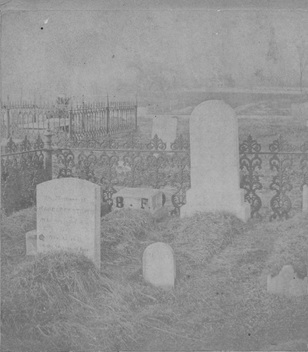 An image taken in 1870 of Barbara Fritchie's original gravesite in the old German Reformed Cemetery (corner of Bentz and W. Second streets) An image taken in 1870 of Barbara Fritchie's original gravesite in the old German Reformed Cemetery (corner of Bentz and W. Second streets) Dame Fritchie was quietly laid to rest beside her husband John in the old German Reformed Church Cemetery located along present day Bentz and W. Second streets (the site of today’s Memorial Park). It was a solemn ceremony attended by family and friends. In 1912, 50 years after her death, it was decided that Barbara be moved to Mount Olivet, the “funerary showplace of Frederick.” This is where Francis Scott Key had been reinterred in 1866 after his original 1843 burial in Baltimore’s St. Paul’s Church Graveyard. In 1898, Key would be reburied, within Mount Olivet, a third (and final) time beneath a grand monument, adjacent the cemetery’s front entrance. Could Frederick do this for one of the Civil War’s greatest civilian hero? Of course, this is Frederick! Many residents of town, dignitaries, bands and a movie crew were on hand for the commemorative exercises planned for May 30th, 1913 as Barbara and husband John were buried along the cemetery’s western border. The chosen area was approved by Fritchie descendants and given the moniker of the Fritchie Triangle, a unique piece of land with special lanes built on all sides to allow tourists and onlookers to visit and pay respects to the lady whose name would grace candy, wallpaper, a restaurant, films and stage plays, a local car dealership and cabin establishment, soda and pork products.  During the re-interment process and immediately after, fund drives included letter-writing campaigns, bake sales, movie/vaudeville nights at the City Opera House. Conducted by the Barbara Fritchie Memorial Association, these efforts procured enough money to build a fitting monument, but not to the scope once imagined. An early rendering for a Fritchie memorial was depicted on a postcard, and captured both literally and figuratively Dame Fritchie’s “larger than life” persona. Unfortunately, it was too large and downright massive—the design resembled a smaller version of the Washington Monument with a proposed location at the intersection of Market and 7th streets (where the fountain resides.) This 7th and Market "behemoth scenario" was successfully thwarted by opponents led by the Baltimore Chapter of the United Daughters of the Confederacy. This organization had vehemently questioned the validity of the Fritchie flag-waving episode for decades. The Fritchie Association regrouped and decided to go with a monument location at the Fritchie gravesite in Mount Olivet. Over a year later, on September 8th, 1914, a more modest monument was erected to memorialize one of the most beloved female characters in American history up to that point. Artist James E. Kelly (1833-1855) sculpted a profile view of Barbara in the form of a large medallion and this was affixed to the large granite shaft. It was reminiscent of the design he utilized 15 years earlier in the completion of the Horatio G. Wright Monument at Arlington cemetery. The monument also included a tablet featuring Whittier’s 1863 ballad for all to read. Lastly, a flag pole was placed behind the monument so all visitors, past, present and into the future, could eyewitness for themselves one of the couplets of the poem: “Over Barbara Frietchie’s grave, flag of freedom and Union, wave!” Barbara would never know of her international fame, but Frederick, Maryland, her residents, picturesque "clustered spires" and Mount Olivet have truly benefitted from it. Would you like to find out more about Barbara Fritchie? Are you interested in learning more about Frederick, Maryland's rich history? This author has the answer for you! History Shark Productions presents:
Chris Haugh's "Frederick History 101" Check out his latest, in-person, course offering: Chris Haugh's "Frederick History 101," with the inaugural session scheduled as a 4-part/week course on Monday evenings in June, 2023 (June 5, 12, 19, 26). These will take place from 6-8:30pm at Mount Olivet Cemetery's Key Chapel. Cost is $79 (includes 4 classes). For more info and course registration, click the button below! (More offerings to come)
0 Comments
Oh Thanksgiving, now in the rear view mirror for this year. This holiday certainly represents so many different things to different people: gathering with family and friends, giving thanks, hunting, eating indulgence, football, fishing and, of course, shopping with those captivated with “Black Friday.” For one couple interred here in Mount Olivet, Thanksgiving represented even something more than the reasons given above. And it’s a safe bet that trout was served alongside turkey as well. A century ago, Frank L. Bentz (Sr.) and Ida May Hagan were married on Thanksgiving Day, 1916. This surely made for terrific wedding anniversary dinners for the next 38 years—leading up to Mr. Bentz’ death in 1955. Both left an impact on the Frederick and Washington county communities, especially on children.  Frank Lawrence Bentz Sr. was born in Frederick on March 1, 1879. In 1911, he removed to nearby Hagerstown and opened a show store with partner John Dunn. After 20 years in business, Bentz retired from the Bentz & Dunn footwear firm in 1932. He would embark on a new career that fast became the love of his life, outside of wife Ida May, of course. This was conservation and fishing. Bentz worked as the popular and highly respected chief clerk of the Maryland Conservation Commission and later became the public relations director for the Maryland Game and Inland Fish Commission. In the latter capacity, he supervised much of the stocking of streams and conservation policies of the commission. At the time of his death, Frank Bentz was said “to have done more than any other Marylander to provide the finest sport for those followers of Izaak Walton.” 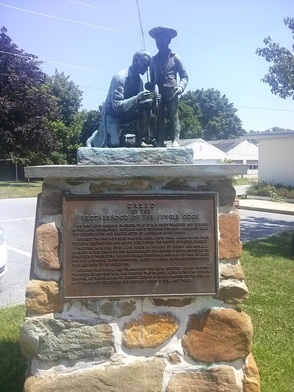 Dedicated in 1953, the Brotherhood of the Jungle Cock Monument is located along Hunting Creek, in front of Old Thurmont Town Office. Dedicated in 1953, the Brotherhood of the Jungle Cock Monument is located along Hunting Creek, in front of Old Thurmont Town Office. After his retirement from his commission post on March 1, 1949 (his sixtieth birthday), Bentz gave much of his time to the Brotherhood of the Jungle Cock, an organization of trout fishing enthusiasts, devoted to teaching youngsters about fishing, conservation of natural resources and, most importantly, good sportsmanship. Bentz was a charter member of the club founded in 1940, along with fishing legend Joe Brooks, Jr. (known as the father of modern fly-fishing”) and J. Hammond Brown (outdoors columnist/editor for the Baltimore Sun and Frederick News-Post). Among his many accomplishments, Mr. Bentz was the first Boy Scout master in Washington County, an active member of the Chamber of Commerce, founder of the Izaak Walton League, one of the first 40 members of the National Guard’s Company A (Frederick), founder of the Conococheague Sportsmen Club and a member of the First Hose Fire Company (Hagerstown). Frank L. Bentz died on June 24, 1955. His legacy lives on in Thurmont, where a body of water, filled with trout, bears his name. This small pond off Maryland Route 77 (east of Catoctin Mountain Park), was created in 1908 when Big Hunting Creek was dammed to power electric generators for Thurmont. In 1955, it was dedicated to the man responsible for the original restoration of the pond, and given the name of the Frank Bentz Memorial Lake. also referred to as Frank Bentz Pond.  Barbara Fritchie Monument, Mount Olivet Cemetery Barbara Fritchie Monument, Mount Olivet Cemetery As for Mrs. Bentz, she was also a native of Frederick, born December 29, 1882. She was a former secretary at Frederick’s Lowenstein and Wertheimer and served as corresponding secretary to the Barbara Fritchie Memorial Association. She prepared the sketch of the monument and the draft of the plaque which were used for the Barbara Fritchie Monument at the relocated grave dedicated in 1914 here at Mount Olivet Cemetery. She was active in the Red Cross and helped organize a Hagerstown public school lunch program designed to feed children whose families could not afford to do so. It is believed that this was the first program of its kind in the country. Ida May Hagan Bentz passed on May 29, 1971 at the age of 89. I find it ironic that a few weeks back, a visitor to the cemetery inquired about gravestones having fish on them. The Bentz’ stone doesn’t, but perhaps it should. NOTE: The Bentz's are buried in Area L (Lot 224). If you have any photos of Mr. or Mrs. Bentz to add to this story, please send to: [email protected]
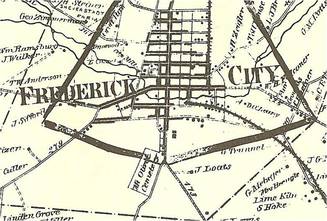 Mount Olivet Cemetery on 1858 Bond Atlas map of Frederick, Maryland Mount Olivet Cemetery on 1858 Bond Atlas map of Frederick, Maryland In the early 1850’s, well before the outbreak of the American Civil War, Frederick City consisted of many downtown-located burying grounds. Most of these adjoined churches and dated back to the founding of Frederick Town in the 1740's. As the town's population grew, so did the churches and their congregations. The graveyards were rapidly reaching capacity for burials. At the same time, churches wanting to expand their structures found themselves "land-locked" thanks to church graveyards abutting or encircling their main structure. A committee was soon formed, comprised of prominent member-representatives from each church. These folks would represent the interest of their individual congregations and discuss a resolution to the problems of not having enough burial space. It was decided that a new cemetery would have to be developed to cater to the needs of an ever-growing Frederick and her religious institutions. This was at the height of the "rural," or "garden," cemetery movement, a new school of thought which began in the large cities of the northeast. Herein, the philosophy toward cemetery design was re-examined. Prior to this time, small urban churchyards were the norm, but the "garden" cemetery movement promoted larger, park-like spaces on the outskirts of town. These cemeteries were planned as public spaces from their inception, and provided a place for all citizens to enjoy refined outdoor recreation amidst art and sculpture. Elaborate gardens were planted and family outings to the cemetery became popular social activities. 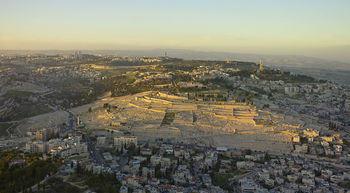 Jerusalem's Mount of Olives (Israel) Jerusalem's Mount of Olives (Israel) What's in a Name? The name Mount Olivet was chosen, perhaps a curious choice for a non-denominational burying ground. The famed Mount of Olives, or Mount Olivet, is a mountain ridge east of, and adjacent to, Jerusalem's Old City. It is named for the olive groves that once covered its slopes. The southern part of the Mount was the Silwan necropolis, attributed to the ancient Judean kingdom. The Mount has been used as a Jewish cemetery for over 3,000 years and holds approximately 150,000 graves. Several key events in the life of Jesus, as related in the Gospels, took place on the Mount of Olives, and in the Acts of Apostles it is described as the place from which Jesus ascended to heaven. The Charter of Mount Olivet Cemetery was recorded among the Land Records of Frederick County on October 4th, 1852. Thirty-two acres were purchased through stock sales, and a rural architect from Baltimore named James Belden was hired to design and lay-out Frederick's new burying ground. The cemetery was dedicated on May 23rd, 1854 amidst great fanfare. The cemetery's first interment occurred on May 30th, 1854. This was Mrs. Ann J. Crawford, around 67 years of age, a house maid working for the family of James Whitehill, a prominent Frederick businessman and one of the founders of the cemetery. 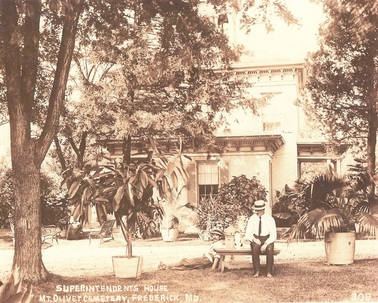 Vintage 1909 photograph of the cemetery with a few decorative plants on the grounds. Vintage 1909 photograph of the cemetery with a few decorative plants on the grounds. Victorian Style, "the Language of Flowers"and Symbolism Mount Olivet’s grounds are made up of hundreds of individual lots, each belonging to individual families. Though little more than cleared farmland in the beginning, early depictions show that many hedges were installed to delineate these property lines and young trees were planted to break the heat of the summer sun. Today these saplings are towering giants that pay homage to all who have passed beneath them. The families continued developing their lots and pictures from the turn of the century show the refinement that had occurred. Walls, fountains and ornate iron fences had been added to grace the gardens. The Victorian Period (1837-1901) defines the period of Queen Victoria's reign over Great Britain. This measured era of both European and American history brought a fascination with the natural world and a keen interest in plants. It became quite fashionable to decorate one's home with exotic, often tropical, plants. This would carry over to cemeteries as well. Palm trees and other rare species (to Maryland) would become part of the Mount Olivet landscape here, necessitating the cemetery's first greenhouse, built to "winter" these tender plants in addition to growing flowers. Many plants and flowers were symbolic to those of the Victorian Age, either through their ‘language of flowers’ or religious beliefs. Lilies, symbolizing resurrection, weeping willows for sorrow and palm fronds and laurel to indicate triumph of the soul are frequently seen on grave markers. Bouquet could be used to send a private message telling of one’s love, or hate. You could also see these plants growing nearby within the cemetery, and in other cases, actually carved in stone on monuments. 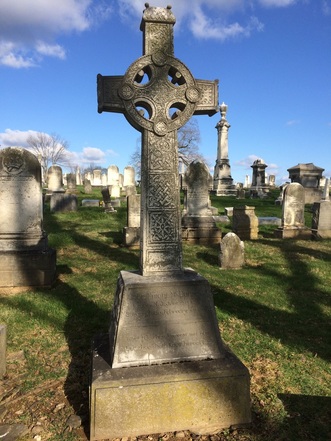 Perhaps no other area of study offers better insight into the Victorian-era fascination with symbolism than that of the nineteenth century cemetery. Even the word "cemetery" has symbolic overtones as it was adapted by the early Christians from the Greek word koimerterion meaning "place of sleep." All cemeteries built during the Victorian period are full of symbolic references from the cemetery's design to the motifs and the design on the monuments. Crosses, obelisks, urns, columns, anchors, angels, cherubs adorn the older sections of the property and send some sort of message about the personality or importance of the inhabitants buried beneath. The connection of stone and religion is strong. Stone conveys images of firmness and timelessness. It is quite natural that both Western and Eastern religions have embraced the use of stone as a media for their grave memorials. The messages conveyed on stone will in theory be eternal and mark an individual's life on earth. Today, in excess of 40,000 graves are occupied, rivaling the living population of our state capital of Annapolis. Eight miles of paved roadway criss-cross the spacious cemetery grounds, allowing for recreational usage by walkers, runners and cyclists acting in a reverent and respectable manner. In addition, the cemetery proudly welcomes history and art lovers, family genealogists, photographers and "tombstone tourists" of all ages.  The United States flag is around us everywhere….and we are especially aware of it in the best of times, and again in the worst of times. One doesn't have to look hard to find our red, white and blue national, and cultural, icon floating on a light breeze. The flag is especially visible on specific holidays steeped in the tradition of flying flags and giving rise to the wearing of the “Stars & Stripes” on one’s own person. Memorial Day, Flag Day (June 14), and the 4th of July annually frame a six-week “gauntlet of patriotism" during the summer. Sometimes overlooked, a day of equal importance is November 11th of each year—Veterans Day. Veterans Day has its origins in Armistice Day, a holiday still celebrated in other countries such as England, France, Belgium, Canada, and Scotland, and marks the anniversary of the end of World War I. The reason for this date-- major hostilities of World War I were formally ended at the 11th hour of the 11th day of the 11th month of 1918, when the Armistice with Germany went into effect. The United States previously observed Armistice Day, but renamed the observance Veterans Day in 1954 at the end of the Korean War.  Dedication of the World War II Monument in Mount Olivet (May 30, 1948) Dedication of the World War II Monument in Mount Olivet (May 30, 1948) Veterans Day honors all military veterans, persons who have served in the United States Armed Forces and differs from Memorial Day where the commemoration is focused on just those who lost their lives while in military service. These men and women, living and deceased should always be revered as brave defenders of the flag. Mount Olivet Cemetery is the eternal home to thousands of US veterans of these 20th century world conflicts. Here, one can also find early patriots such as Thomas Johnson, Jr. and Sons of Liberty who took up arms in the Revolutionary War for American Independence.  Francis Scott Key gazes upon the "Star-Spangled Banner" flying atop Baltimore's Fort McHenry. Francis Scott Key gazes upon the "Star-Spangled Banner" flying atop Baltimore's Fort McHenry. No country loves their flag more than the United States, this is widely known. And no town loves the faithful “red, white and blue” more than Frederick, Maryland. In fact, a handful of former Fredericktonians, known nationally (and internationally) have the flag to thank for their immortal rise to fame. Each are considered heroes in their own right, accomplishing something amazing while adjacent a U. S. flag under attack by a warring enemy. Francis Scott Key is one of the heroes of the War of 1812, and resides in historic Mount Olivet Cemetery. Key was not an officer, and a marginal soldier at best. However, he put pen to paper “at the dawn’s early light” after seeing the flag flying atop war-torn Fort McHenry on September 14, 1814, thus giving us four stanzas of verse. Key’s “Star-Spangled Banner” would eventually become our country’s national anthem. While visiting Frederick on August 6th, 1834, Francis Scott Key made a speech at Courthouse Square during a large ceremonial banquet. Many veterans of the War of 1812 were in the audience and this would be one of a few rare occasions in which Key discussed his remembrances associated with writing the Star-Spangled Banner. Key would give credit to these former soldiers: "The song, I know, came from the heart, and if it has made its way to the hearts of men, whose devotion to their country and the great cause of freedom I know so well, I could not pretend to be insensible to such a compliment. With it came an inspiration not to be resisted; and even though it had been a hanging matter to make a song, I must have written it. Let the praise, then, if any be due, be given not to me, who only did what I could not help doing; not to the writer, but to the inspirers of the song!” …I again thank you for the honor you have done me; but I can only take the share of it. I was but the instrument in executing what you have been so pleased to praise; it was dictated and inspired by the gallantry and patriotism of the sons of Maryland. The honor is due, not to me who made the song, but to the heroism of those who made me make it…  The daring and loyal Barbara Fritchie The daring and loyal Barbara Fritchie Nearly fifty years later, another interred resident of Mount Olivet would defend the flag and her beloved "boys in blue.' This was not a soldier, however, but a humble female resident of town. Barbara Fritchie alleged flag-waving exploits in the face of an invading Confederate Army helped re-energize both Union soldiers and citizens. John Greenleaf Whittier’s popular poem gave posthumous immortal fame to the local heroine, but more importantly painted Frederick-Town and its “clustered spires” as a place of patriotism and allegiance to the flag.  Admiral Winfield Scott Schley Admiral Winfield Scott Schley Two neighbors of “Dame Fritchie” served proudly for the Union, each hailing from some of Frederick’s founding German families: the Schleys and Steiners. Although named for a famed Army general, Rear Admiral Winfield Scott Schley would enjoy a much decorated career in the United States Navy. After graduation from the Academy in Annapolis, Schley aptly found himself in naval service during the Civil War. His greatest moment however, came more than three decades later in Santiago, Cuba during the Spanish-American War. Here he commanded his squadron’s flagship, “the U.S.S. Brooklyn” and is credited for destroying the Spanish fleet under Admiral de Cervera. Schley’s autobiography, published in 1904, is entitled Forty-five years Under the Flag. Admiral Schley's was laid to rest in Arlington Cemetery, however his parents, siblings and countless other relatives reside at Mount Olivet. In addition, a captured gun from the Spanish fleet was on display for many years at the foot of the Francis Scott Key Monument.  The final resting place of Dr. Lewis H. Steiner is located in Area G of the cemetery The final resting place of Dr. Lewis H. Steiner is located in Area G of the cemetery Dr. Lewis H. Steiner did not achieve the iconic fame of the other three Fredericktonians, but certainly made a name for himself through his leadership of relief efforts under the flag of the United States Sanitary Commission. He rose quickly through the ranks of the commission to become Chief Inspector for the Army of the Potomac. Although Dr. Steiner served in the healing side of the Army, he certainly had the militaristic spirit in his blood. His grandfather had commanded a Frederick artillery unit in the 1812 conflict, and his great uncle was captain of a Frederick infantry unit. Dr. Steiner's son, Bernard Christian Steiner, would serve as master of ceremonies at the dedication of the Francis Scott Key Memorial in 1898. 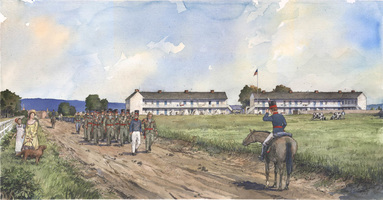 A depiction of Frederick's historic "Hessian Barracks" during the war of 1812 A depiction of Frederick's historic "Hessian Barracks" during the war of 1812 All of these former residents of Frederick were well acquainted with the Frederick Barracks located on the campus of the Maryland School for the Deaf. Erected during the Revolutionary war for the purpose of housing military prisoners (both British and Hessian), this historic structure never came under attack by the enemy. However, it has proudly stood under a “Star-Spangled Banner” for its entire existence, witnessing the drilling and mustering of local militia companies in various conflicts. It also housed Union General Hospital #1, consisting of Civil War medical staffs caring for the wounded and sick of both armies. 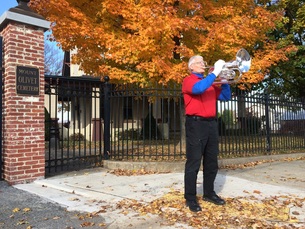 Just outside the cemetery's gates, Frederick "Echo Taps"organizer Fred Schumacher pays respect to all veterans, past and present, through his trusty instrument. Just outside the cemetery's gates, Frederick "Echo Taps"organizer Fred Schumacher pays respect to all veterans, past and present, through his trusty instrument. One block to the south, Mount Olivet Cemetery has been a safekeep of local veterans who unselfishly traveled the country and/or world in an attempt to protect our flag, our "Star-Spangled Banner, and the freedom and independence we have continued to enjoy since 1776. We are honored to have Frederick's annual "Echo Taps" event start at our front gate each November 11th.
|
STORIES
|
Archives
July 2024
June 2024
May 2024
April 2024
March 2024
February 2024
January 2024
December 2023
November 2023
September 2023
August 2023
July 2023
June 2023
May 2023
April 2023
March 2023
February 2023
January 2023
December 2022
November 2022
October 2022
September 2022
August 2022
July 2022
June 2022
May 2022
April 2022
March 2022
February 2022
January 2022
December 2021
November 2021
October 2021
September 2021
August 2021
July 2021
June 2021
May 2021
April 2021
March 2021
February 2021
January 2021
December 2020
November 2020
October 2020
September 2020
August 2020
July 2020
June 2020
May 2020
April 2020
March 2020
February 2020
January 2020
December 2019
November 2019
October 2019
September 2019
August 2019
July 2019
June 2019
May 2019
April 2019
March 2019
February 2019
January 2019
December 2018
November 2018
October 2018
September 2018
August 2018
July 2018
June 2018
May 2018
April 2018
March 2018
February 2018
January 2018
December 2017
November 2017
October 2017
September 2017
August 2017
July 2017
June 2017
May 2017
April 2017
March 2017
February 2017
January 2017
December 2016
November 2016

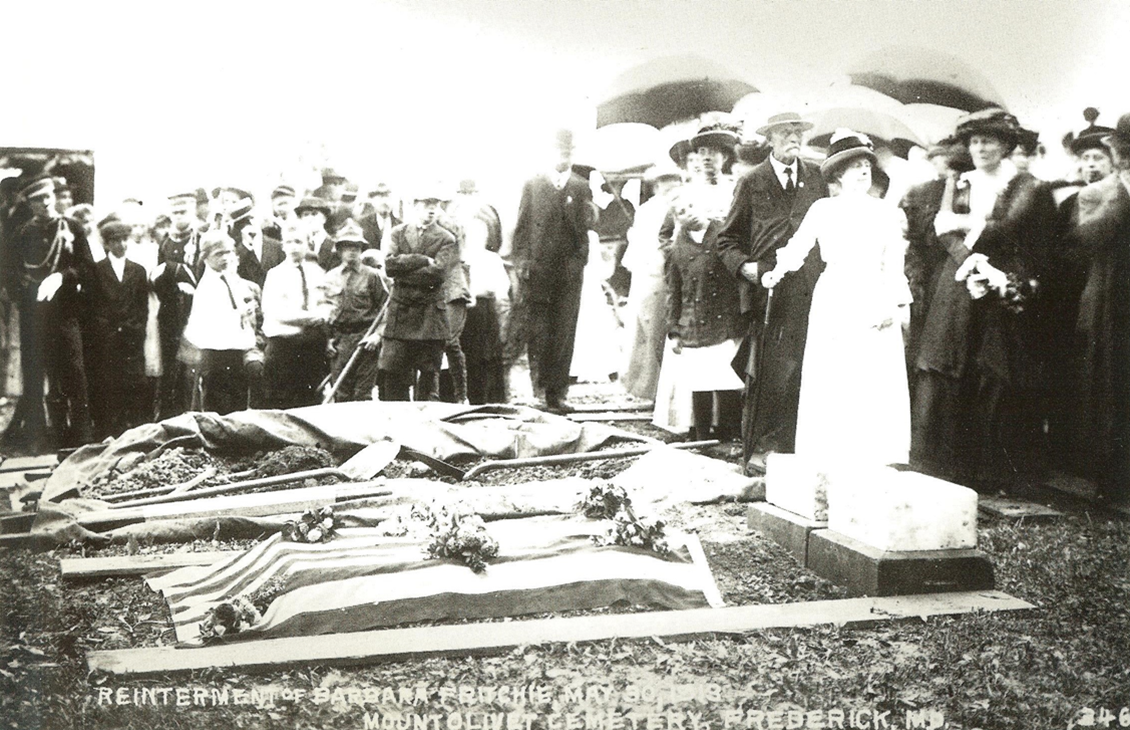














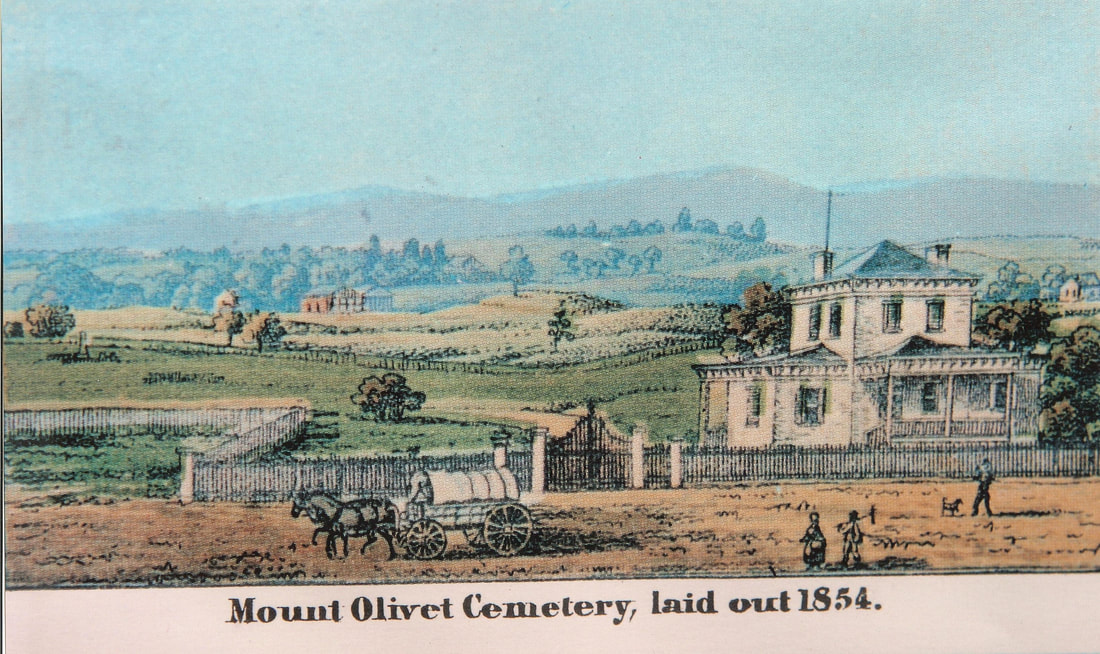




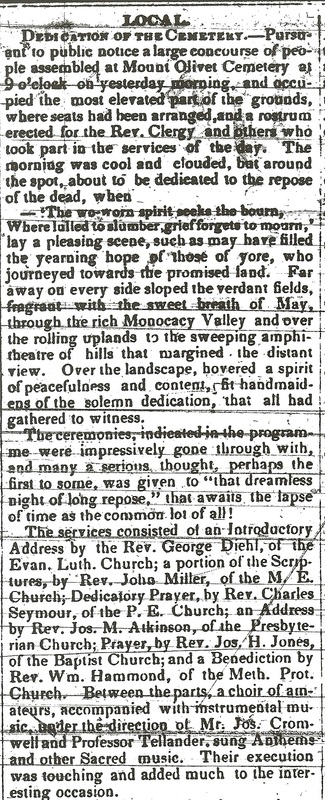


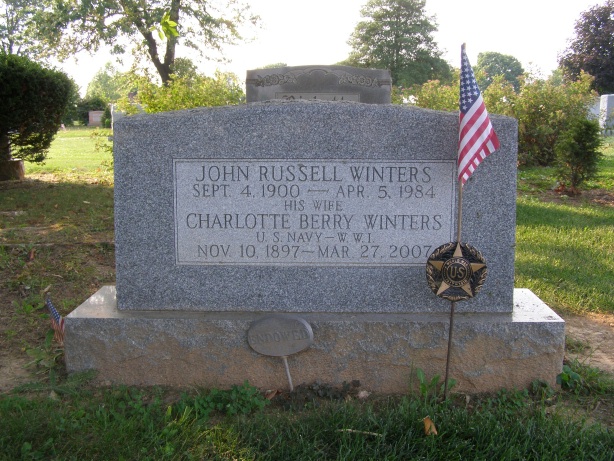

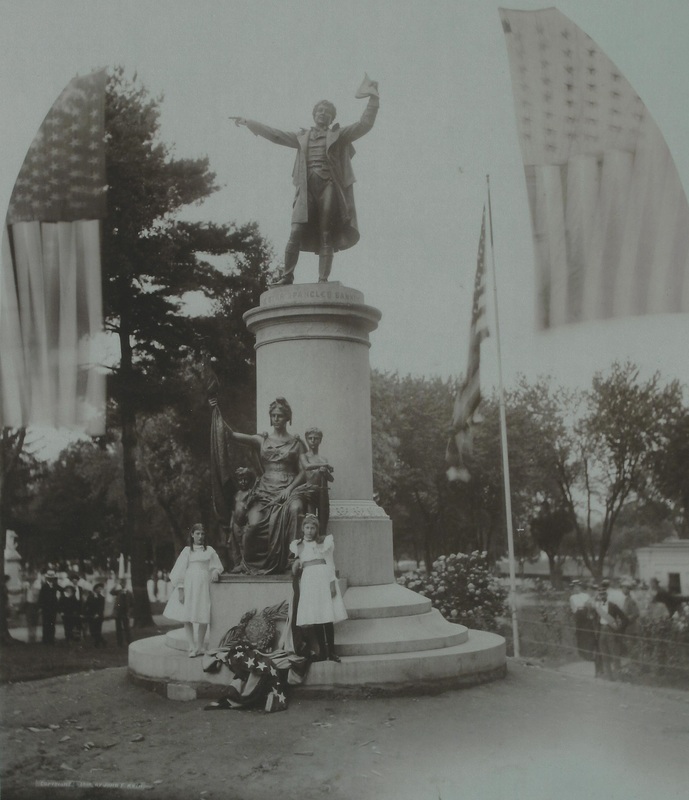



 RSS Feed
RSS Feed